Even Trump's Base Seems To Prefer His Less 'Trumpy' Tweets
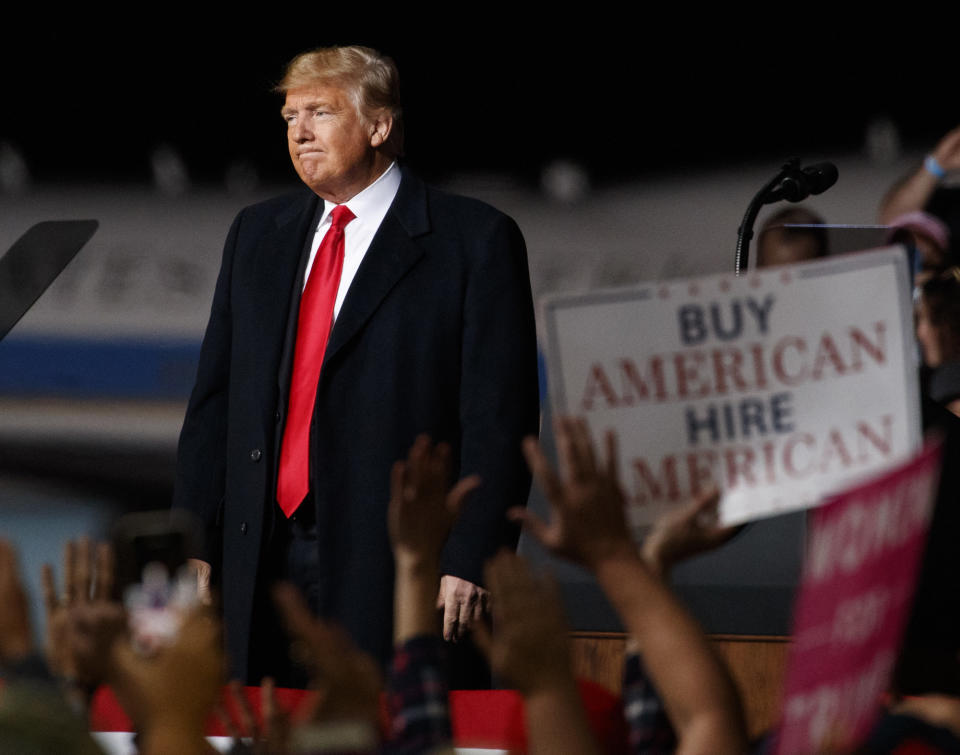
President Donald Trump’s most palpably vitriolic tweets, like the recent tirade in which he called Stormy Daniels a “horseface” and Sen. Elizabeth Warren (D-Mass.) “Pocahontas,” are often seen as red meat for his base.
The insults are certainly unlikely to repel the minority of Americans who support him, all of whom have already stuck with him through worse. Tracking polls show that Trump’s approval rating among his own voters is as high this week as it’s ever been during his administration.
But there’s also data to suggest that even the president’s backers tend to prefer his more anodyne tweets over habit of disparaging his opponents on Twitter. That’s especially true of the women who voted for him, as well as for voters who didn’t consider him their preferred Republican candidate in 2016.
Starting soon after Trump’s inauguration, the polling firm YouGov has been asking Americans to rate his tweets on a five-point scale ranging from “terrible” to “great.” A 56 percent majority of the public called the “horseface” tweet terrible or bad, with 17 percent calling it OK, and 28 percent saying it was good or great. Unsurprisingly, most Democrats ― 70 percent ― considered it terrible.
Members of his own party were a lot more positive. Sixty percent of Republicans rated the tweet positively, with 20 percent giving it a negative score. Forty-two percent thought it was great, and just 10 percent that it was terrible.
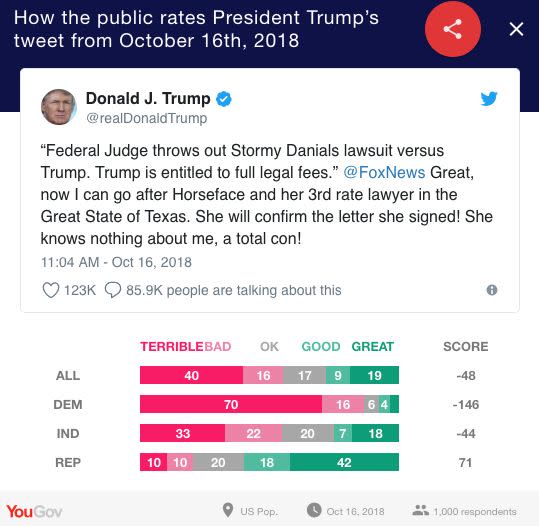
Trump drew a fairly similar response for a tweet calling Elizabeth Warren “Pocahontas” and a “phony”. A 57 percent majority of the country rated that message negatively, but 59 percent of Republicans rated it positively, with 41 percent proclaiming it a great tweet.
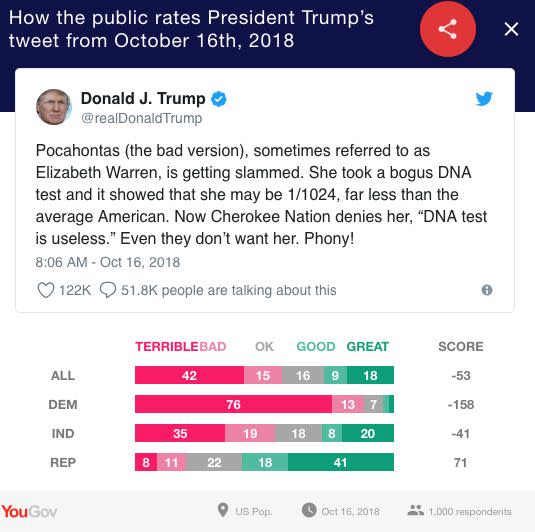
But even those in-party ratings are comparatively low, relative to the scores Republicans gave him for what might be termed more typically “presidential” tweets, of the kind that tout jobs numbers, commiserate with hurricane victims or praise national institutions. One Trump tweet, three days before the “horseface” tweet, wished the Navy a happy birthday. That drew a positive score from 84 percent of Republicans, with 69 percent calling it a great message.
The pattern holds for Trump’s tweet canon writ at large. Some of Trump’s least popular tweets to date are his personal attacks against people like Mark Cuban (“not smart enough to run for president”), Mika Brzezinski (“bleeding badly from a face-lift”), Don Lemon (“the dumbest man on television”) and Omarosa Manigault-Newman (“a crazed, crying lowlife”). His best received include those honoring World War II veterans, first responders and the U.S. Women’s Hockey Team. One analysis of the YouGov data found that “Trump-ier tweets tend to be less popular than tweets that sound like they’re staff-written,” even among Republicans.
Some of Trump’s supporters are more receptive to his vindictiveness than others, as a new HuffPost/YouGov poll shows.
More than 90 percent of Trump voters currently approve of the way he’s handling his job as president overall. But only about half believe that his tweets usually help his cause ― and the number is even lower among his female supporters and among those who backed a different candidate in the 2016 primary.
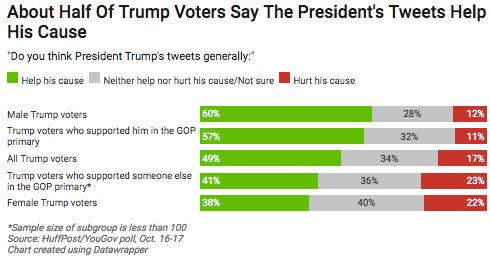
Overall, 64 percent of Trump voters believe it’s appropriate for the president to attack individuals’ policy positions, but just 32 percent say it’s appropriate for him to levy personal attacks.
A 43 percent plurality of male Trump voters, but just 19 percent of female Trump voters, say that personal attacks are acceptable. And 37 percent of voters who supported Trump in the primary find the personal attacks appropriate, compared to just 20 percent of those who embraced him only in the general election.
Love HuffPost? Become a founding member of HuffPost Plus today.
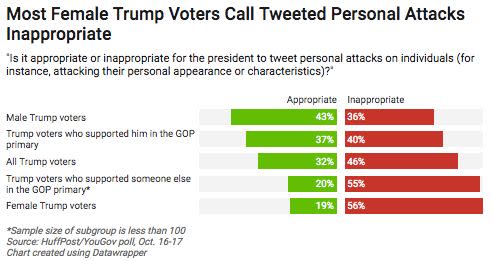
Those numbers reflect a theoretical sense of propriety, which doesn’t entirely seem to translate into actual outrage when Trump does, inevitably, return to airing his grievances on Twitter. (Otherwise, the ratings for the “horseface” tweet would be a lot lower among Republicans.)
But mostly, Trump’s supporters appear to think the discussion of his tweeting habits is just overblown: Sixty-five percent say the media pays too much attention to what the president says on Twitter. For once, the sentiment is something approaching bipartisan, with half of Hillary Clinton voters saying the same.
Like the rest of the country, Trump voters are far more likely to encounter Trump’s tweets through media coverage than they are to see them directly on Twitter. Just 14 percent of Trump voters and 11 percent of Americans as a whole say they learn about something Donald Trump has posted on Twitter because they saw it on the site. Two-thirds of Trump voters and 64 percent of all Americans say they’re more likely to come across them in a news story.
Use the widget below to further explore the results of the HuffPost/YouGov survey, using the menu at the top to select survey questions and the buttons at the bottom to filter the data by subgroups:

The HuffPost/YouGov poll consisted of 1,000 completed interviews conducted Oct. 16-17 among U.S. adults using a sample selected from YouGov’s opt-in online panel to match the demographics and other characteristics of the adult U.S. population.
HuffPost has teamed up with YouGov to conduct daily opinion polls. You can learn more about this project and take part in YouGov’s nationally representative opinion polling. More details on the polls’ methodology are available here.
Most surveys report a margin of error that represents some, but not all, potential survey errors. YouGov’s reports include a model-based margin of error, which rests on a specific set of statistical assumptions about the selected sample rather than the standard methodology for random probability sampling. If these assumptions are wrong, the model-based margin of error may also be inaccurate. Click here for a more detailed explanation of the model-based margin of error.
This article originally appeared on HuffPost.

